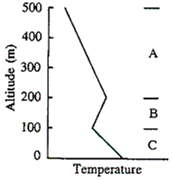Species richness is affected by many variables. As one travels toward higher latitudes, one would expect ________
A) species richness to be fairly constant B) population viability to increase
C) species richness to increase D) species richness to decrease
D
You might also like to view...
Mixing
Refer to the figure below.

A. about 0 m B. about 100 m C. about 200 m D. about 400 m
Consider an early reef-builder of the Cambrian, the archaeocyathid. Using correct terminology
for marine ecosystems, classify this organism on where it lives, how it gets around, and how it feeds. How does the lifestyle of archaeocyrathids compare with that of Cambrian trilobites? What will be an ideal response?
Mountain building and erosion near convergent plate boundaries commonly expose rocks that formed in the middle crust at depths of 15 to 20 km below the surface. These rocks include plutonic-igneous rocks and metamorphic rocks
The metamorphic rocks formed under both regional and contact metamorphic conditions. What combination of field and laboratory observations could you make to distinguish the effects of the two sets of conditions? In developing your answer, assume that the rocks contain aluminum silicate polymorphs, and use the graphs in Figures 6.5 and 6.18 to guide your thinking. What will be an ideal response?
The Green Revolution of the 20th century was characterized by ________
A) increased awareness of the environment and environmental issues B) increased use of environmentally sound products C) advancements in agricultural techniques D) increased concern for the environment